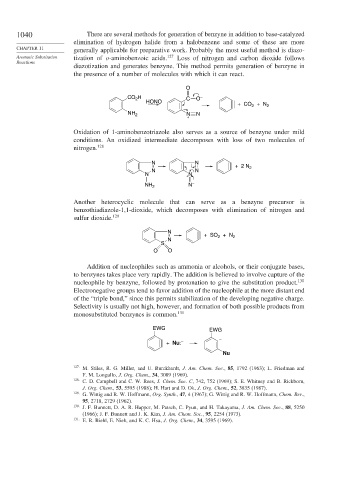Page 1064 - Advanced Organic Chemistry Part B - Reactions & Synthesis
P. 1064
1040 There are several methods for generation of benzyne in addition to base-catalyzed
elimination of hydrogen halide from a halobenzene and some of these are more
CHAPTER 11 generally applicable for preparative work. Probably the most useful method is diazo-
Aromatic Substitution tization of o-aminobenzoic acids. 127 Loss of nitrogen and carbon dioxide follows
Reactions
diazotization and generates benzyne. This method permits generation of benzyne in
the presence of a number of molecules with which it can react.
O
CO H C O –
2
HONO
+ CO + N 2
2
NH 2 N N
+
Oxidation of 1-aminobenzotriazole also serves as a source of benzyne under mild
conditions. An oxidized intermediate decomposes with loss of two molecules of
nitrogen. 128
N N
+ 2 N 2
N N
N + N
–
NH 2 N
Another heterocyclic molecule that can serve as a benzyne precursor is
benzothiadiazole-1,1-dioxide, which decomposes with elimination of nitrogen and
sulfur dioxide. 129
N
+ SO + N 2
2
N
S
O O
Addition of nucleophiles such as ammonia or alcohols, or their conjugate bases,
to benzynes takes place very rapidly. The addition is believed to involve capture of the
nucleophile by benzyne, followed by protonation to give the substitution product. 130
Electronegative groups tend to favor addition of the nucleophile at the more distant end
of the “triple bond,” since this permits stabilization of the developing negative charge.
Selectivity is usually not high, however, and formation of both possible products from
monosubstituted benzynes is common. 131
EWG EWG
–
+ Nu: –
Nu
127
M. Stiles, R. G. Miller, and U. Burckhardt, J. Am. Chem. Soc., 85, 1792 (1963); L. Friedman and
F. M. Longullo, J. Org. Chem., 34, 3089 (1969).
128 C. D. Campbell and C. W. Rees, J. Chem. Soc. C, 742, 752 (1969); S. E. Whitney and B. Rickborn,
J. Org. Chem., 53, 5595 (1988); H. Hart and D. Ok, J. Org. Chem., 52, 3835 (1987).
129
G. Wittig and R. W. Hoffmann, Org. Synth., 47, 4 (1967); G. Wittig and R. W. Hoffmann, Chem. Ber.,
95, 2718, 2729 (1962).
130 J. F. Bunnett, D. A. R. Happer, M. Patsch, C. Pyun, and H. Takayama, J. Am. Chem. Soc., 88, 5250
(1966); J. F. Bunnett and J. K. Kim, J. Am. Chem. Soc., 95, 2254 (1973).
131
E. R. Biehl, E. Nieh, and K. C. Hsu, J. Org. Chem., 34, 3595 (1969).

